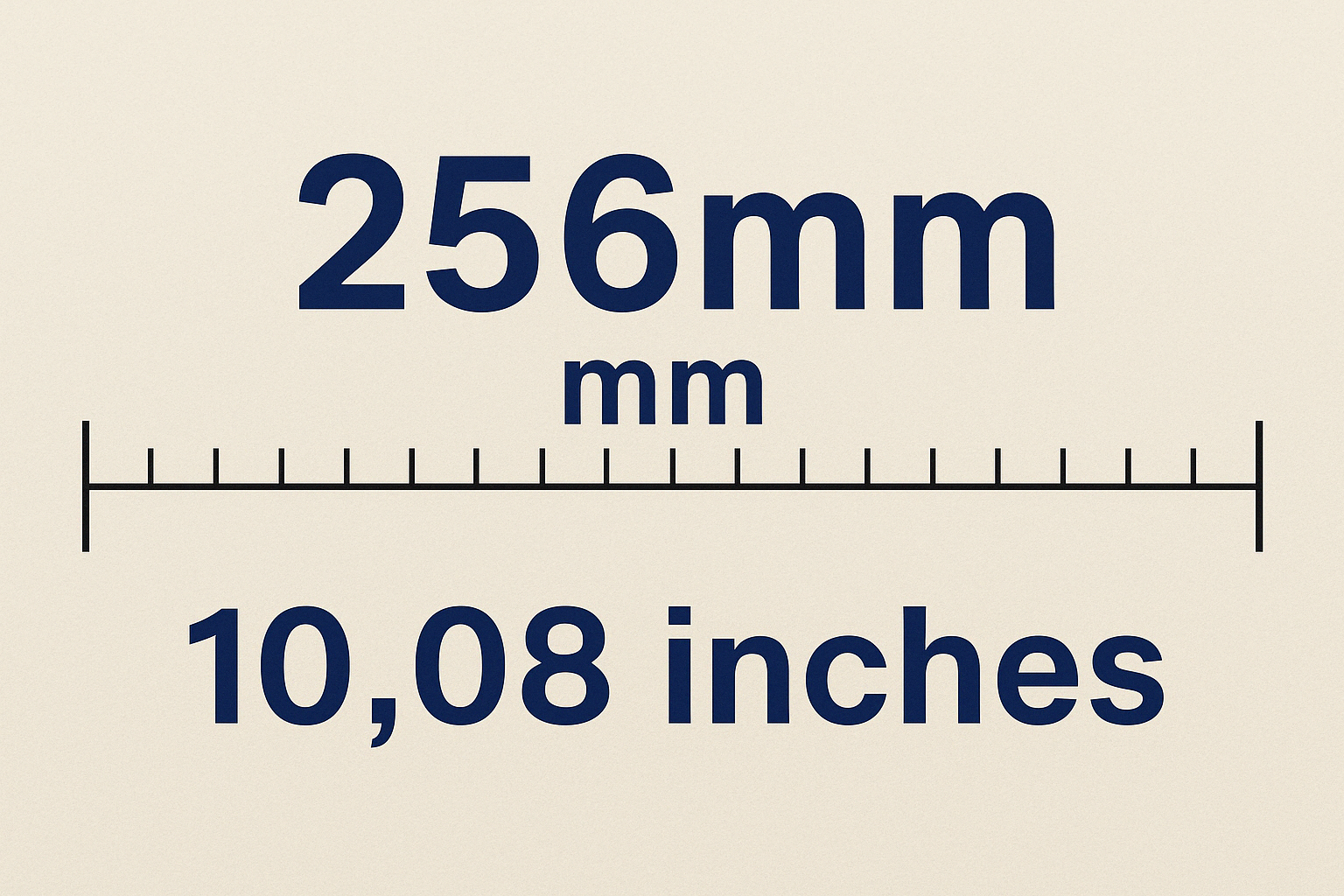
256mm equals 10.08 inches – visual conversion chart for easy reference
Introduction
Why You Might Need to Convert 256mm to Inches
Let’s be honest—most of us don’t walk around knowing what 256 millimeters means in inches off the top of our heads. But if you’ve ever shopped online for tools, parts, or home goods, you’ve probably come across sizes listed in millimeters when you’re used to inches. Whether you’re in the U.S. or just prefer the imperial system, converting 256mm to inches becomes more of a necessity than a curiosity. Maybe you’re installing a new kitchen cabinet, measuring a screen size, or cutting materials for a home project—whatever the task, knowing how to switch between units can save you time and frustration. It’s not just about getting a number right—it’s about making sure what you buy fits, what you build works, and what you imagine becomes real. And when it comes to a specific figure like 256mm, it’s important to get the decimal right too. Even a slight miscalculation could result in a costly mistake. So, if you’ve ever asked, “How many inches is 256mm?”—you’re in the right place. We’re going to break it all down simply, without complicated jargon or math anxiety.
Everyday Situations Where This Conversion Helps
You’d be surprised how often knowing the inch equivalent of 256mm comes in handy in real life. Let’s say you’re buying a piece of furniture from a European brand that lists its product dimensions in millimeters. A drawer labeled as 256mm wide doesn’t give you an instant mental picture unless you’re familiar with metric measurements. For someone used to thinking in feet and inches, converting that into a familiar format is essential. Or maybe you’re working on a DIY project that involves woodwork or metal cutting, and your measuring tools are in inches while your blueprint uses millimeters. This happens a lot when you mix tools or tutorials from different regions. Even if you’re a tech enthusiast, 256mm could pop up when dealing with screen sizes, lens diameters, or hardware specifications. In all these cases, a quick and correct conversion saves you from errors, returns, or do-overs. So, whether you’re a student, designer, craftsman, or just someone assembling IKEA furniture, understanding how 256mm fits into the inches world helps you move forward with confidence.
Understanding the Basics
What Is a Millimeter?
A millimeter (mm) is a small unit of length in the metric system, and it’s often used in contexts where precision matters. It’s one-thousandth of a meter, making it a very fine measurement. If you’ve ever looked at a ruler with tight lines between each centimeter, those smaller lines are millimeters—ten of them make up one centimeter. The metric system is widely used around the world because of its simplicity and decimal-based logic. In fields like science, engineering, medicine, and even manufacturing, millimeters offer the precision needed for tight tolerances. You’ll see mm used in car parts, smartphones, watches, and even clothing sizes. The beauty of millimeters is that they allow for high-detail measurements without requiring complex fractions. While millimeters might feel “too small” for some daily tasks, they’re incredibly useful when every bit of size counts. Whether you’re measuring a screw or tracking the thickness of a sheet of paper, mm gives you that control. It’s worth getting familiar with, even if you’re more accustomed to inches, because metric is becoming more common globally—even in countries that use the imperial system.
What Is an Inch?
An inch is a unit of measurement commonly used in the imperial system, especially in the United States. It’s a standard go-to for measuring everything from the height of a person to the size of your television screen. One inch is equivalent to 25.4 millimeters, which means it’s significantly longer than a millimeter and often used for bigger, more general-purpose measurements. Inches are divided into fractions—like halves, quarters, eighths—which makes them great for carpentry, home improvement projects, and daily usage. While the inch isn’t as universally used as the millimeter, it holds strong in many industries and households, especially in North America. If you’ve ever ordered a 13-inch laptop or a 32-inch TV, you’ve already relied on this unit. It’s all about what feels familiar—if you’re used to inches, then hearing “256mm” might not mean much until you translate it into your everyday measuring language. Understanding what an inch is and how it compares to a millimeter is the first step toward making accurate conversions and better decisions, especially when size truly matters.
Millimeters vs Inches: Key Differences
Millimeters and inches measure the same thing—length—but in very different ways. The biggest difference lies in the size of the units themselves. One inch equals exactly 25.4 millimeters, so it’s much larger than a millimeter. This makes millimeters great for very fine, precise measurements, like in engineering, tech design, or medical equipment. Inches, on the other hand, are often better suited for broader, more general measurements like home furniture, screen sizes, or clothing. Another key difference is how these units are structured: millimeters belong to the metric system, which is decimal-based and easier for calculations. Inches are part of the imperial system, which relies on fractions (like 1/2, 1/4, 1/8), and while useful in some hands-on fields, it can feel less intuitive for beginners. If you’re moving between international standards—say, buying something from Europe but measuring it in the U.S.—you’ll often need to go back and forth between these systems. Understanding these differences helps reduce confusion and avoid costly errors in design, fitting, and manufacturing.
The Math Behind It
The Exact Formula to Convert mm to Inches
Now let’s talk numbers, but don’t worry—we’re keeping it simple. To convert millimeters to inches, you use one straightforward formula:
inches = millimeters ÷ 25.4
That’s it. No complicated equations, no memorizing weird conversions—just divide the number of millimeters by 25.4, and boom, you’ve got inches. This is because one inch is equal to exactly 25.4 millimeters. So when you’re converting 256mm to inches, you’d do this: 256 ÷ 25.4, which gives you approximately 10.08 inches. Easy, right? This formula works universally for any mm to inches conversion and helps you stay accurate. Whether you’re designing a product, measuring for construction, or double-checking part sizes for an order, this little formula is a lifesaver. Just remember: always keep a calculator handy, and double-check your decimals if precision is important. It may seem like a small detail, but in many fields, it’s a big deal.
How 256mm Converts to Inches Step-by-Step
Alright, let’s walk through converting 256mm to inches the manual way. This will give you clarity and confidence that you’re doing it right.
Step 1: Start with your measurement in millimeters: 256mm.
Step 2: Use the formula: inches = mm ÷ 25.4
Step 3: Plug in the value: 256 ÷ 25.4 = 10.0787
Step 4: Round off (if needed): The result is about 10.08 inches.
That’s your final answer. Now here’s where it gets real: depending on your purpose, you might round that to just 10.1 inches or keep it more precise. If you’re dealing with machine parts, you probably want to keep all those decimals. But if you’re printing a label or estimating space in your room, rounding up makes sense. The key takeaway? Follow the steps, use a reliable calculator or conversion tool, and match the precision to your need. It’s not about being perfect; it’s about being accurate where it matters.
Manual Conversion vs Calculator Method
Both manual and calculator-based conversions work well—but which one is best for you? Manual conversion gives you a better understanding of the actual math behind the scenes. If you’re someone who works in a technical field or simply likes knowing the “why” behind the numbers, doing the math manually (like we just did with 256 ÷ 25.4) makes a lot of sense. It builds your confidence in measurements and makes you less dependent on tools.
However, calculators and online converters offer unmatched convenience. You just enter 256mm and get instant results in inches. If you’re on the go, handling multiple sizes, or just don’t want to risk a math mistake, a converter is your best friend. The catch? Not all tools are equally accurate, and sometimes they round off too early. That’s why it helps to understand the math even if you mostly rely on tools. In short, manual conversion gives clarity, and calculators give speed. Ideally, use both—understand the process and use tools to save time.
Quick Conversion Tools
Online Tools to Instantly Convert mm to Inches
There’s no shortage of quick tools online that will convert 256mm to inches in a flash. Websites like unitconverters.net, rapidtables.com, or even Google Search can instantly give you the answer just by typing in “256mm to inches.” These platforms are user-friendly, free, and available 24/7. Some even offer extra features like rounding options, fractional conversions, and reverse calculations. You’ll also find mobile apps that do the same job, which can be a huge help when you’re working on-site, in a shop, or even while shopping online.
The beauty of these tools is their speed. You don’t need to remember formulas or carry a notepad. Just input your value, hit convert, and you’re done. However, not all tools show the same level of precision. Some round off too early, or may not clarify how they calculated the value. So it’s always a good idea to use trustworthy websites and double-check if your work depends on tight tolerances. But for casual use or even most professional scenarios, these converters are the ultimate time-savers.
Are Online Converters Always Accurate?
Online converters are incredibly helpful, but are they always accurate? The answer is yes—but with conditions. Most reputable sites and apps base their calculations on the correct formula (mm ÷ 25.4), so the math itself is sound. Where issues sometimes come up is in rounding. Some converters might round too early or limit decimal places by default. For example, 256mm technically converts to 10.0787 inches, but some tools may simply return 10.1 inches, which could throw off precise tasks like machining or technical drawings.
Another issue is ads and pop-ups on certain free platforms, which can distract you or even lead to clicking the wrong value. Also, if you’re working offline or in a low-connectivity area, these tools aren’t always accessible. The solution? Know the formula, double-check your conversions, and—when it matters—go for precision. Bookmark 1–2 reliable websites and consider downloading an app for offline use. That way, you’re never caught off guard.
Real-Life Examples
256mm Size in Home Appliances
You’d be amazed how often measurements like 256mm show up in household items, especially if you shop internationally. Let’s say you’re buying a European-designed microwave or kitchen drawer. Many of these appliances list their dimensions in millimeters, and a depth or width of 256mm is common for mid-sized components. But unless you’re familiar with metric measurements, you might not realize that 256mm equals around 10.08 inches. That could mean the difference between a perfect fit or a return trip to the store.
Even wall-mounted shelves or light fixtures can come with installation guides using millimeters. If your measuring tape only shows inches, a simple misunderstanding of the size could lead to holes drilled in the wrong place. When planning a layout or adjusting space for cabinetry, being able to visualize what 256mm looks like in inches helps make quicker, more accurate decisions. So next time you see “256mm” on a product box or installation manual, don’t skip it—translate it. Your home projects will thank you.
256mm in DIY Projects and Crafts
If you’re into DIY projects—whether it’s building a table, installing curtain rods, or creating handcrafted art—256mm is a measurement you could encounter more than you think. Maybe you’re cutting wood panels, setting screw holes, or working on a piece that needs to fit into a tight spot. Knowing that 256mm equals just over 10 inches can help you avoid measurement mistakes that might waste materials or throw off your entire plan.
It’s especially important in projects that require symmetry. Imagine you’re making a shelf that needs to be 256mm wide on both sides, but you accidentally convert it as 11 inches instead of 10.08. That small mistake becomes a big deal when the pieces don’t match. Plus, DIY tools sold in different countries might have instructions in mm, so converting those accurately is key. Keeping a mini conversion chart or app nearby can save you time and effort. Mastering this one measurement gives you an edge in crafting and designing with confidence.
256mm in Industrial or Tech Usage
In more technical or industrial settings, precision is king—and that’s where 256mm can carry even more weight. Let’s say you work in manufacturing, product design, or tech hardware. A 256mm part might be part of a larger system where every millimeter matters. Even in computer hardware, you’ll see components like monitor stands, PC cases, or even circuit boards with exact mm measurements. If you misinterpret 256mm and assume it’s a rough 10 inches without checking the decimals, the entire fit could be off.
Engineers and machinists often switch between metric and imperial systems, especially if their tools are designed internationally. Being fluent in both units ensures better communication and accuracy in planning, prototyping, and final production. In these fields, 256mm is not “just a number”—it’s a potential risk point if misunderstood. Even software designers who create physical tech products often specify dimensions in mm, especially for global distribution. So in industrial applications, accurate conversion isn’t optional—it’s essential.
Common Mistakes to Avoid
Confusing mm with cm or inches
One of the most common blunders people make is mistaking millimeters for centimeters—or even inches. It’s easy to assume “256mm” is the same as “256cm” or close to 256 inches if you’re not paying close attention. But in reality, 256mm is 25.6 centimeters and only about 10.08 inches. That’s a massive difference depending on what you’re working on. Imagine trying to fit a 10-inch item into a space you thought was 25 inches wide!
Another mistake is flipping the conversion—using 25.4 as a multiplier instead of a divider. That’ll give you a result 25 times larger than what you need. This can lead to wrong orders, mismatched components, and a lot of wasted time. The fix? Always double-check the unit—mm, cm, or inches—and apply the correct formula. Use parentheses when entering numbers into calculators and avoid rounding off early. It sounds simple, but a little focus here can save big headaches later.
Rounding Too Early in Conversion
Rounding is another sneaky mistake that causes issues, especially with tight-fit applications. When converting 256mm to inches, the exact value is 10.0787 inches. But if you round this too early—say to just 10 inches—you lose the accuracy that might be critical depending on what you’re doing. This might not matter much if you’re measuring for a picture frame, but in technical settings or customized fittings, even a tenth of an inch can throw things off.
Sometimes tools or calculators round results automatically to two decimal places or even to whole numbers. Always look for an option that gives you full precision or at least double-check with a manual calculation. The best rule of thumb? Round only when you’re confident it won’t affect the result in a meaningful way. It’s better to start precise and simplify if needed than to guess and get it wrong. A few extra decimal points might just save your project.
Other Metric to Imperial Tips
How to Convert Inches to mm Backward
Understanding conversions both ways gives you a real edge, especially when you’re working across both metric and imperial systems. While we’ve talked a lot about converting 256mm to inches, it’s equally useful to know how to go backward—from inches to millimeters. The reverse formula is just as simple:
millimeters = inches × 25.4
So, for example, if you have a measurement like 10 inches and want to know how many mm that is, you’d do:
10 × 25.4 = 254mm
That’s pretty close to our original 256mm, which is why many people casually refer to 256mm as “around 10 inches.” But if accuracy is important—like in design, tech, or engineering—it’s best to calculate the precise value. Knowing both directions of this conversion can save you from making incorrect adjustments and helps when you’re reading charts, comparing tools, or using international tutorials that flip between systems.
Quick Reference Chart for Similar Measurements
Sometimes you just need a quick cheat sheet instead of doing the math every time. Below are a few handy metric-to-inch conversions that are close to 256mm. You can keep this chart near your workstation or bookmark it for quick access.
| Millimeters (mm) | Inches (approx.) |
| 250mm | 9.84 inches |
| 255mm | 10.04 inches |
| 256mm | 10.08 inches |
| 260mm | 10.24 inches |
| 265mm | 10.43 inches |
This small chart helps when you’re working with a range of measurements and want to estimate quickly without doing full calculations each time. It’s especially useful in settings like furniture building, tech installations, or shopping for parts online where measurements fall in similar ranges. Keeping a reference like this can save you both time and trouble.
Helpful Tips and Tricks
Memory Hacks to Remember the Formula
We’ve all been there—trying to remember formulas on the fly and drawing a blank. But here’s a simple memory trick: “Inch means divide, mm means multiply.” Just remember that to go from mm to inches, you divide by 25.4. And to go from inches to mm, you multiply by 25.4. It’s a single number you need to know, and once you lock that in, switching between systems becomes second nature.
Another fun way to remember: think of a ruler. On one side, you’ll often see inches, and the other side has millimeters. It’s literally a conversion in your hand. Using these tools visually helps solidify the formula in your mind. Over time, common conversions like 256mm to 10.08 inches will become second nature, especially if you work with these units regularly.
When to Round and When to Keep it Exact
Not every measurement needs to be carried out to the fourth decimal point. Sometimes, a rounded number works just fine—especially in casual situations like estimating space for furniture or printing an approximate label. But other times, rounding too early can cause problems. So how do you know when to round?
If you’re in technical fields—like engineering, machining, or product design—keep it exact. Every decimal can impact functionality or fit. But if you’re just putting up a picture frame or cutting a garden hose, rounding to one decimal (like 10.1 inches) is usually fine. A good general rule is: round only when exactness won’t affect the outcome. Use common sense and match the level of precision to the job at hand.
Conclusion
Final Thoughts on Converting 256mm to Inches
Converting 256mm to inches might seem like a small task, but it’s a gateway to getting real-world projects right. Whether you’re designing, building, fixing, or just shopping smartly, knowing how to shift between units helps you avoid mistakes, save money, and stay efficient. We learned that 256mm is about 10.08 inches, and that converting it is as easy as dividing by 25.4. But more than just memorizing a number, we explored why this matters—from home use to industrial needs.
This isn’t just about math—it’s about real-world functionality. The more familiar you get with these conversions, the more confident you’ll be in making choices, measuring materials, or evaluating specs. And once you’ve got this down, other conversions become easier too.
Why Knowing These Conversions Matters
In a world that’s increasingly connected, dealing with mixed measurement systems is almost unavoidable. Maybe you’re collaborating on international projects, buying imported products, or following online tutorials from other countries—metric and imperial conversions will keep popping up. That’s why knowing how to convert measurements like 256mm to inches isn’t just helpful—it’s essential. It makes you a better planner, a more precise worker, and someone who saves both time and money by getting it right the first time.
So the next time you’re faced with a measurement in millimeters, don’t sweat it. Just remember: divide by 25.4, stay aware of rounding, and trust your knowledge. Simple, smart, and super handy—just like this guide was meant to be.
FAQs
How many inches is 256mm exactly?
256 millimeters is equal to 10.08 inches. You get this by dividing 256 by 25.4, which is the conversion factor between mm and inches. It’s an exact calculation used in everything from DIY work to technical specs.
Can I round 256mm to 10 inches?
You can round it to 10 inches for general use, but the exact value is 10.08 inches. If you’re working on a project where precise fit matters, like in carpentry or hardware installation, it’s better to stick with the exact number.
What’s the easiest way to convert mm to inches?
The easiest method is to divide the mm value by 25.4. You can also use Google or online conversion tools—just type “256mm to inches” and get the result instantly. For fast and frequent conversions, mobile apps can be even more convenient.
Why does the 256mm measurement matter?
256mm comes up often in product dimensions, especially in furniture, tools, and tech gadgets from metric-using countries. If you’re more familiar with inches, converting helps ensure you understand the real size and make accurate decisions when buying or building.
Is 256mm a standard size in anything?
While it’s not a “standard” size across all industries, 256mm is commonly seen in appliance widths, drawer measurements, screen sizes, and construction elements. It’s a mid-range measurement that fits well into many design and hardware specifications.





